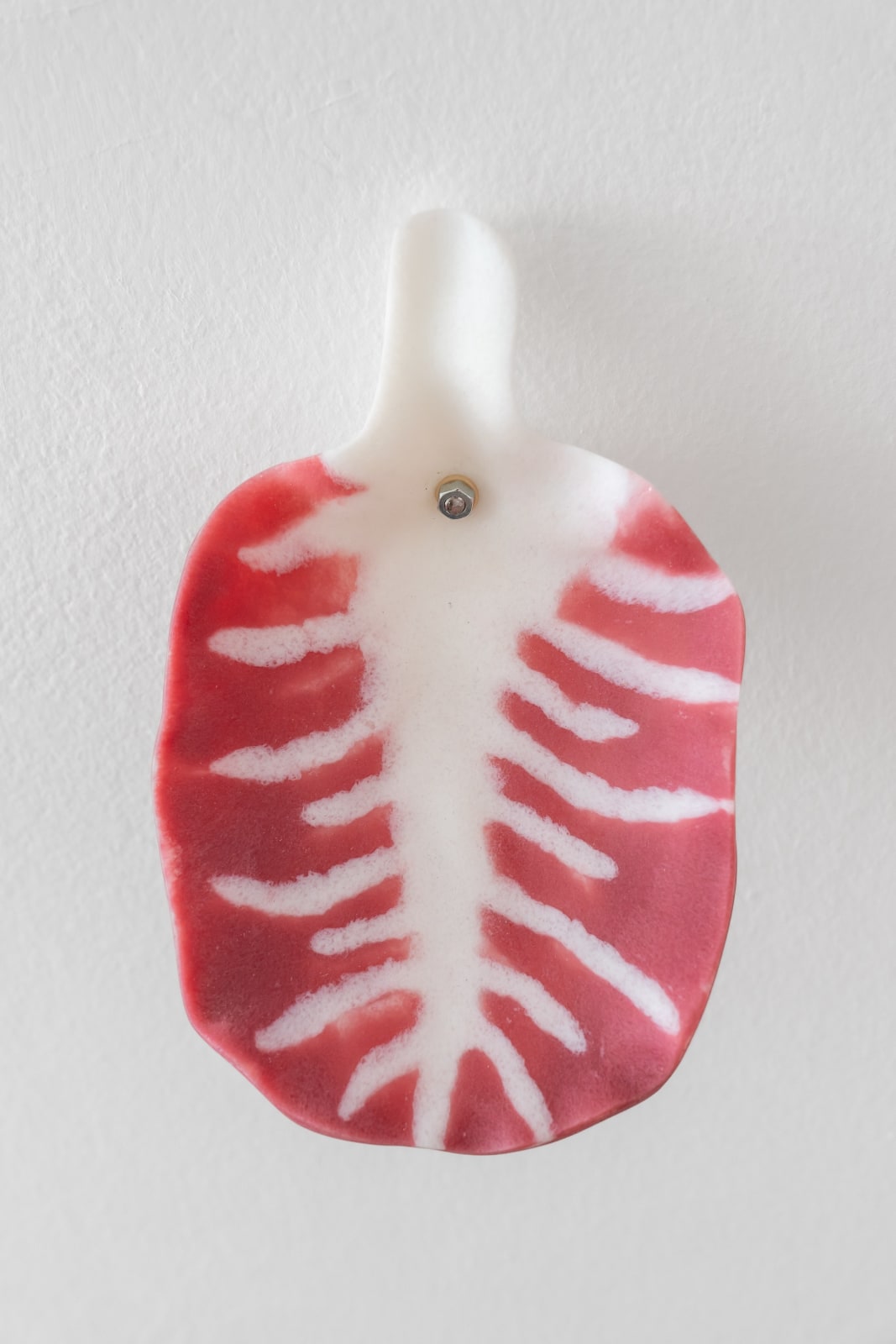Anne Duk Hee Jordan
Radicchio Leaf, 2023
Casted glass
30 x 30 x 8 cm (each)
11 3/4 x 11 3/4 x 3 1/8 inches (each)
11 3/4 x 11 3/4 x 3 1/8 inches (each)
Copyright The Artist
Photo: Dirk Tacke
Further images
Mit „Radicchio Leaf“ (2023) überführt Anne Duk Hee Jordan die filigranen Strukturen von Salatblättern in Glas. Die Arbeit wirkt organisch und künstlich zugleich und macht damit jene Übergänge sichtbar, die...
Mit „Radicchio Leaf“ (2023) überführt Anne Duk Hee Jordan die filigranen Strukturen von Salatblättern in Glas. Die Arbeit wirkt organisch und künstlich zugleich und macht damit jene Übergänge sichtbar, die das gesamte Werk durchziehen: zwischen biologischen Systemen und technischen Apparaturen, zwischen Realität und spekulativer Konstruktion. Diese Ambivalenz ist charakteristisch für den Umgang mit Natur als Erzählraum, der nicht bloß abbildet, sondern vieldeutige Welten eröffnet. In den skulpturalen und installativen Arbeiten Jordans entstehen hybride Ökosysteme, in denen sich Mensch, Maschine und Natur durchdringen. „Radicchio Leaf“, das als modische Zutat als Symbol für monokulturelle Landwirschaft steht, übersetzt diese Denkweise in eine stille, fast kontemplative Geste: ein künstlich erzeugtes Blatt aus Glas, das in seiner Zerbrechlichkeit auf die Fragilität ökologischer Systeme und das ausbeuterische Verhältnis des Menschen zur Natur verweist.
Im Kontext der Ausstellung wird „Radicchio Leaf“ Teil eines größeren Narrativs über Transformation, Kontrolle und symbiotische Verflechtung. Die Werke changieren zwischen Forschung und Fiktion – alternative Weltentwürfe entstehen, in denen der Mensch nicht mehr im Zentrum steht, sondern eingebettet ist in ein vielschichtiges, verletzliches Gefüge.
With "Radicchio Leaf" (2023), Anne Duk Hee Jordan transforms the delicate structures of salad leaves into glass. The work seems organic and artificial at the same time, thereby revealing the transitional zones that run throughout her entire oeuvre: between biological systems and technical apparatuses, between reality and speculative construction. This ambivalence is characteristic of her approach to nature as a narrative space—one that does not merely represent but provides access to ambiguous worlds.
In Jordan’s sculptural and installation works, hybrid ecosystems emerge in which humans, machines, and nature interpenetrate. "Radicchio Leaf", through referencing a trendy ingredient and symbol of monocultural agriculture, translates this line of thought into a quiet, almost contemplative gesture: a man-made leaf of glass points in its fragility to the vulnerability of ecological systems and the exploitative relationship between humans and nature.
In the context of the exhibition, "Radicchio Leaf" becomes part of a broader narrative about transformation, control, and symbiotic interconnection. The works oscillate between research and fiction—alternative world models emerge in which the human is no longer at the center but embedded within a multilayered, fragile structure.
Im Kontext der Ausstellung wird „Radicchio Leaf“ Teil eines größeren Narrativs über Transformation, Kontrolle und symbiotische Verflechtung. Die Werke changieren zwischen Forschung und Fiktion – alternative Weltentwürfe entstehen, in denen der Mensch nicht mehr im Zentrum steht, sondern eingebettet ist in ein vielschichtiges, verletzliches Gefüge.
With "Radicchio Leaf" (2023), Anne Duk Hee Jordan transforms the delicate structures of salad leaves into glass. The work seems organic and artificial at the same time, thereby revealing the transitional zones that run throughout her entire oeuvre: between biological systems and technical apparatuses, between reality and speculative construction. This ambivalence is characteristic of her approach to nature as a narrative space—one that does not merely represent but provides access to ambiguous worlds.
In Jordan’s sculptural and installation works, hybrid ecosystems emerge in which humans, machines, and nature interpenetrate. "Radicchio Leaf", through referencing a trendy ingredient and symbol of monocultural agriculture, translates this line of thought into a quiet, almost contemplative gesture: a man-made leaf of glass points in its fragility to the vulnerability of ecological systems and the exploitative relationship between humans and nature.
In the context of the exhibition, "Radicchio Leaf" becomes part of a broader narrative about transformation, control, and symbiotic interconnection. The works oscillate between research and fiction—alternative world models emerge in which the human is no longer at the center but embedded within a multilayered, fragile structure.





